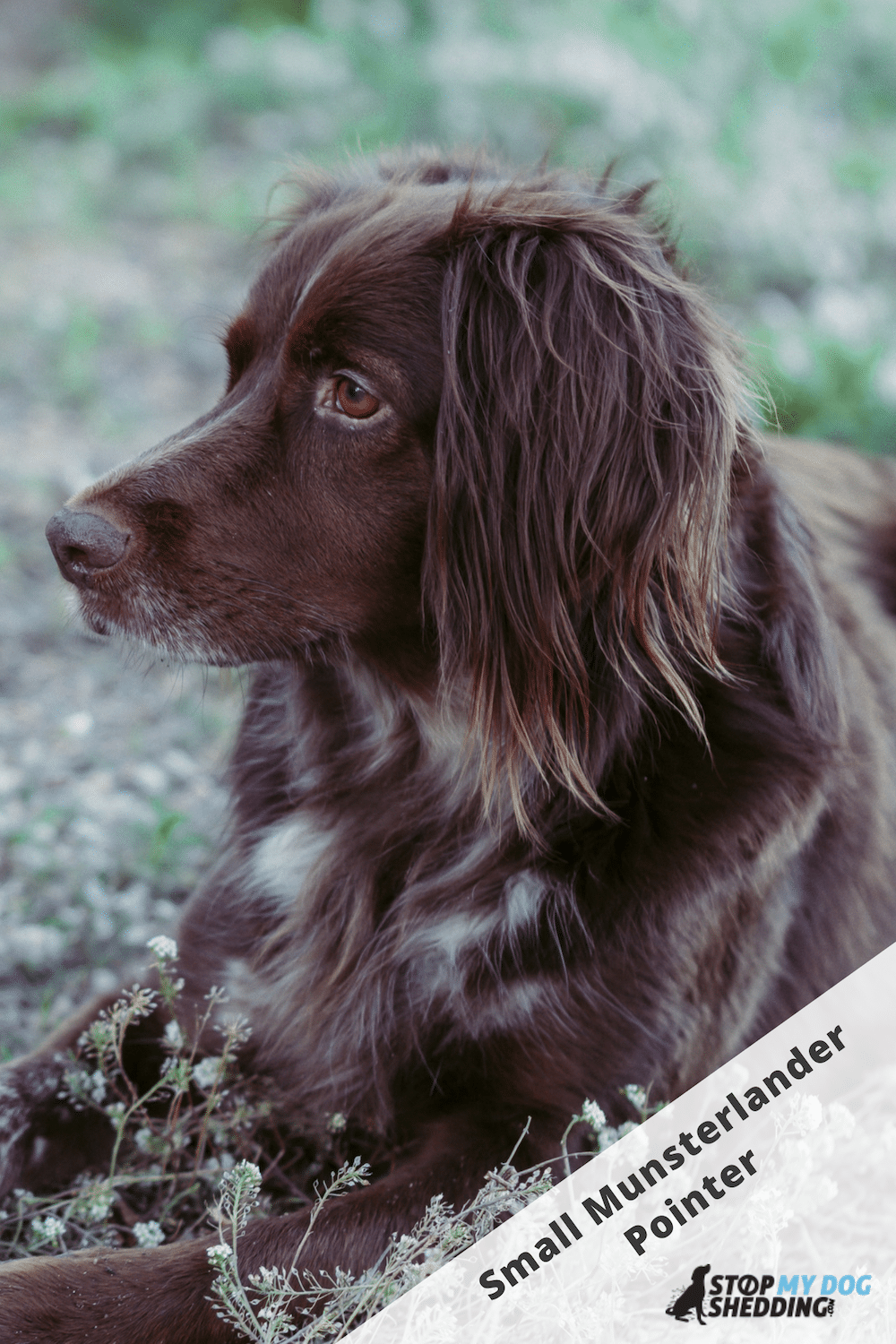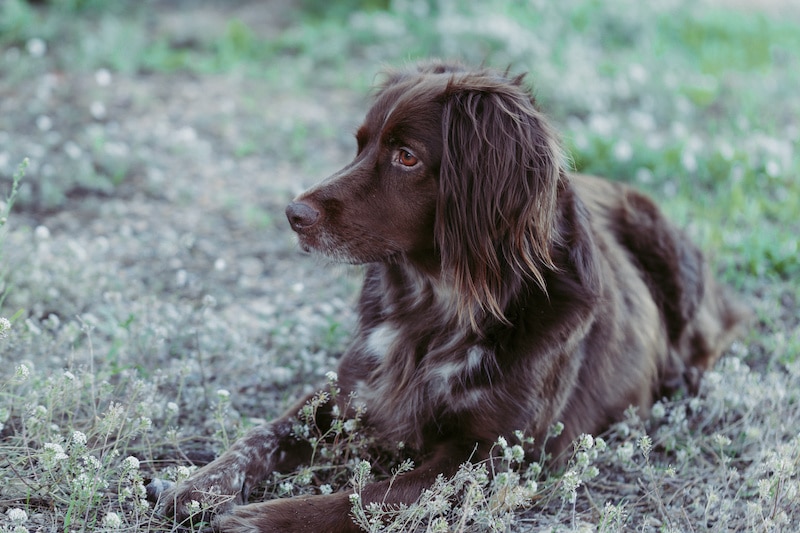Small Munsterlanders are versatile German hunting dogs that are known for being loyal companions. Whether he’s hunting furry prey on land, retrieving in the water, or sitting at your feet, these intelligent and highly trainable dogs love being by your side.
Do they shed? Small Munsterlander Pointers shed a moderate amount of hair year round, although you should expect to see an increase in shedding during spring and autumn when they blow their coat. Regular brushing with a slicker brush and metal comb can minimize this significantly.
In this article, we’ll be exploring just how much shedding they do and what you can do to minimize it, so you can enjoy the company of a Small Munsterlander as well as a fur free home.
Small Munsterlander Shedding
Small Munsterlanders shed a moderate amount of hair year round, and more during seasonal changes like spring and fall.
Shedding is normal in most dogs, even high levels of shedding depending on the breed. It’s just a process whereby the old hair stops growing and falls out, to make way for the new batch.
And some dogs, like the Small Munsterlander, have thick double coats that shed seasonally. Which means there’s about a 2-4 week period (twice per year) that you’ll notice more fur floating around.
The reason they shed more heavily in spring is because they don’t need their thick winter coat during the summer months. And likewise, they shed their summer coat in the fall to make way for a thicker winter coat.
Related: Do German Shorthaired Pointers Shed?
This process is often referred to as “blowing coat” and when it happens for the first time (once they’re past the puppy stage) it can seem a bit outrageous. Because if you kept all the fur they lost during this time it can almost look like you’ve got a second dog!
But unless there’s some sort of underlying concern, this is normal. The only real solution would be to shave him but this is not a good idea because they need their double coat. It protects them from the cold and heat, as well as the harsh conditions they was bred for in Germany back in the mid to late 1800s.
With that being said, there are some things you can do to both limit how much hair they lose and how much of it ends up on your floors, furniture and clothes. And it mostly comes down to grooming.
What Are They Like to Groom?
Like most Pointers, grooming your Small Munsterlander Pointer isn’t very difficult. These dogs were bred tough and ready to hunt, so they don’t need much in the way of special attention.
A good brush once per week is enough to maintain his coat as well as a quick brush if he’s been running around outside, as it is not uncommon for debris to get caught up in the coat.
What sort of brush should you use?
Well, to answer this we first need to consider what sort of coat they have. Because the type of brush you use depends on the dog’s coat. And Small Munsterlanders have a double coat.
The top coat is medium in length, water-repellent and can be brown and white or brown roan. It is close lying over most of the body except around the ears and legs where you will notice some feathering. As for their undercoat, this is soft and dense.
There’s no hard and fast rule as to exactly which brush is best, but a slicker brush and metal comb work well on coats like this.
A slicker is a brush that is made up of fine wire bristles and plastic or rubber tips on the end, and these work well on dogs with a medium or long coat. While a comb (or deshedding tool) is good for getting down into the undercoat to remove as much of the dead fur as possible.
Start with a slicker brush to remove the bulk of dead fur from their coat, along with any mats and tangles. And finish up with the comb or deshedder to remove the loose fur from the undercoat.
Other general maintenance items include a good bathe once per month or so, regularly trimming his nails and cleaning his teeth and ears.
Recommended: Go here to see our top-rated dog hair blow dryers
Are Small Munsterlanders Hypoallergenic?
No, Small Munsterlanders are not hypoallergenic.
But the truth is, no dog is fully hypoallergenic. Even completely hair free dogs like the American Hairless Terrier can cause problems for people who are sensitive to pet allergies.
This is because the dog’s dander (flaky skin) is the true culprit. Not the hair itself. However, because dander attaches itself to a dog’s fur, higher shedding breeds will naturally spread more dander. So (generally speaking) the higher a dog sheds, the less suitable they are for allergy sufferers.
The Small Munsterlander isn’t the worst choice you could make in this respect, but he’s not the best either. Nor are similar pointing and hunting breeds like the Brittany or his close relative, the Large Munsterlander.
If you’re looking for a non-allergenic hunting dog, the Irish Water Spaniel or Welsh Terrier may be a better fit. Or if you don’t care about their hunting or working ability, the Italian Greyhound or Basenji are worth checking out.
Recommended: Go here to see our top-rated dog hair blow dryers
Can You Stop Your Small Munsterlander from Shedding?
You can’t stop a dog from shedding, but you can minimize it significantly. And out of all the methods of reducing shedding we talk about on this site, the simplest and most effective is regular brushing.
Because first and foremost, brushing removes the old fur from his coat before it falls off and causes you to have to clean it up. Second, brushing is good for his coat because it spreads his skin oils.
And a healthy, moisture rich coat is much less likely to shed excessively than a dry or irritated one. So keeping his coat in good shape is a must when it comes to reducing shedding.
Aside from brushing, keeping an eye on what you’re feeding your Small Munsterlander can make a big difference. Opt for good quality dog foods that are rich in vitamins, minerals and fatty acids like Omega 3.
Related: Does Olive Oil Help Reduce Shedding?
Bathing is another good way to remove the dead fur before it falls out. You don’t want to over bathe him, but once per month a bath in warm water with a quality dog shampoo can help to remove and loosen the old hairs on his coat prior to a good brushing session.
You might be surprised at the difference this can make. Not just immediately after bathing but in some cases for days and weeks afterwards. It’s important not to bath too often though, as this can cause his skin and hair to dry out which can lead to excessive shedding.
The good news is that none of these shedding solutions are difficult or expensive. They do take consistent effort, especially during shedding season, but the end result is enjoying the companionship of this unique dog, without spending unnecessary amounts of time cleaning up loose fur.













Please note: By submitting a comment using the above comment form, you confirm that you agree with the storage and handling of your data by this site as detailed in our Privacy Policy.